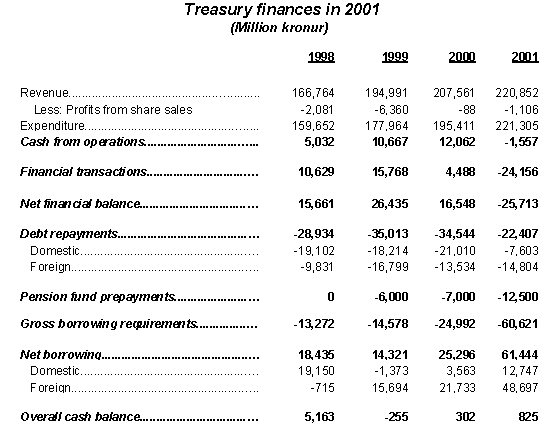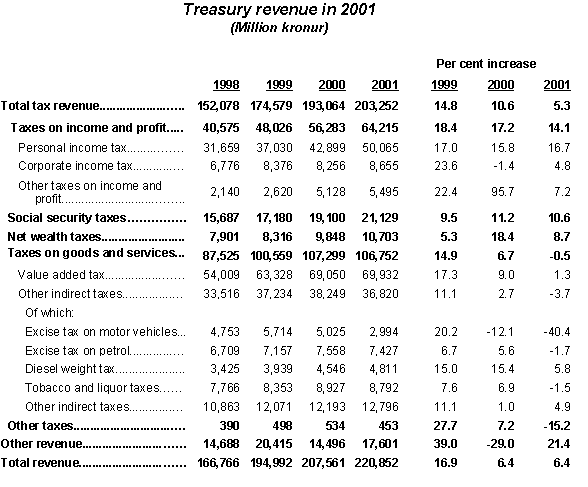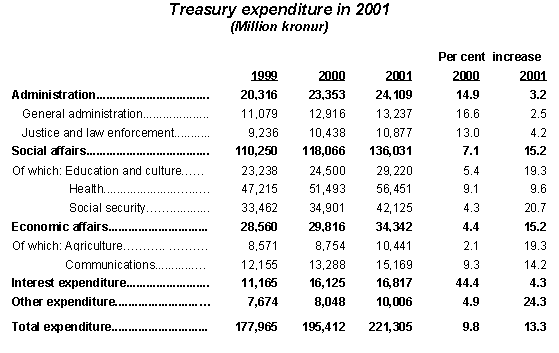Treasury finances in 2001. Report date: February 13, 2002.
This report is available in PDF form (PDF 27K)
Preliminary figures for Treasury finances for 2001 are now available. They are presented on a cash basis and are therefore not comparable to the Treasury accounts or the fiscal budget, both of which are presented on an accruals basis.
Summary
The cash deficit from operations amounted to 1S billion kronur for the year as a whole, compared to a surplus of 12.1 billion kronur a year ago. The main reason for the reversal is attributable to the change in the economic environment in the course of 2001 which was reflected both in contracting revenue and increased expenditure due to rising inflation and a declining exchange rate. Total revenue increased by close to 13.2 billion kronur or 6S per cent from last year, which was largely in line with budget projections except for proceeds from asset sales which fell short of the budget by 14 billion since plans for privatising the Telecommunications Company and the state-owned commercial banks could not be carried out as planned.
The increase in expenditure amounted to 25.9 billion kronur. The largest part of the increase is due to the impact of wage agreements, the development of the exchange rate and domestic inflation which together account for some two-thirds of the increase. Furthermore, payments to the newly created Childbirth Leave Fund, to the Municipal Equalisation Fund, a special payment to the disability pension scheme and payments for the purchase of farm production quotas are the largest other items of expenditure increase. Total expenditure exceeded budget by 10.3 billion kronur, two-thirds of which is due to inflation. The remainder is due to the extraordinary factors noted above, and 1.5 billion is attributable to interest payments in excess of budget.

The net financial deficit amounted to 25.7 billion kronur, mainly because the Treasury borrowed 25 billion kronur abroad in order to strengthen the equity position of the Central Bank and its foreign exchange reserves. Furthermore, considerable sums have been allocated in recent years in order to reduce the future pension commitments of the Treasury with extraordinary contributions to the Government Employees Pension Fund. These payments amounted to a total of 12S billion in 2001 for a total of 25 billion since 1998.
Revenue
The Treasury's total revenue amounted to 220.9 billion kronur in 2001, 15 billion less than estimated in the budget. This is wholly attributable to the fact that proceeds from asset sales fell far short of the budget. Other revenue was largely in concert with budget estimates. Total tax revenue amounted to 203.3 billion, about 1 billion less than budgeted, a divergence of S per cent. The composition of revenue, however, differed considerably in respect of individual revenue items. The personal income tax and the social security tax exceeded budget estimates by 6 billion, whereas indirect taxes fell short of budget by 7 billion.
These developments reflect the change in economic conditions in the course of the year. The expansion of the past three to four years was succeeded by a stagnation, particularly in domestic demand, which in turn meant a reduction in the Treasury's revenue growth. The change in tax revenue clearly reflects this turnaround. Tax revenue increased by 15 per cent in 1999, 10 per cent in 2000, whereas in 2001 the increase was down to 5 per cent.

Proceeds from indirect taxes, on the other hand, are nearly constant from the previous year, amounting to close to 107 billion in 2001, about S billion less than in 2000 and 7 billion less than budgeted, reflecting a 6 per cent decline in real terms. This clearly reflects the slowdown in the economy that has been in evidence in the course of this year, particularly in consumer spending on durable goods such as autos and appliances. The largest deviation from the budget takes place in the value-added tax which fell short of the budget by 4 billion. The excise tax on motor vehicles declined by 40 per cent or by 2 billion. The decline in indirect taxes was offset by increased income taxes, both from the personal income tax and the social security tax, reflecting a considerable increase in wages between 2000 and 2001 which is reflected in the wage index that rose by 8.8 per cent.
The corporate income tax and the capital income tax are largely in concert with the fiscal budget. The same applies to the net wealth tax, both for individuals and corporations, as well as to other Treasury revenue, except for proceeds from the sales of assets.
Expenditure
Total expenditure amounted to 221.3 billion kronur in 2001. Expenditure increased by 25.9 billion or by just over 13 per cent. The cause of the increase is to be found in wage agreements, the development of the exchange rate and in domestic inflation. These factors account for about two-thirds of the increase. In addition, new expenditure items were introduced into the budget, such as 2.8 billion to the Childbirth Leave Fund that commenced in 2001 and an increase in the appropriation to the Municipal Equalisation Fund by 1 billion. A special one-time payment for disability pensions amounted to 1.3 billion and a new Social Security Act led to an increase of 700 million. Increases in excess of inflation also took place for secondary schools as well as in health and communications.

Administrative expenditure
increased by close to 800 million kronur, or 3.2 per cent from last year. This is due mostly to a purchase of new information systems for the government at a cost of 550 million. Offsetting this to some degree is a decline in the combined expenditure by 300 million on the Presidency, the Althingi, the Supreme Court and the Prime Minister's Office.
Social affairs. Close to 60 per cent of expenditure in 2001 went to social affairs, including education, culture, health and social security. Expenditure in this category rose by 18 billion from the previous year. Expenditure for education rose by 4.1 billion of which 2.4 million went to secondary and special schools, an increase of 34.3 per cent, most of which is due to wage increases following new pay contracts at the beginning of 2001. Payments to the Student Loan Fund increased by 410 million.
Health expenditure increased by 5 billion and amounted to 56S billion. Of this increase, 3 billion is due to increased operating expenditure of hospitals, an increase of 10.7 per cent. Of this increase, 2.1 billion were incurred by the large hospitals in Reykjavík and Akureyri, although the largest increases in percentage terms went to nursing homes and rehabilitation facilities. The increase to those institutions amounted to 1.1 billion or 13.3 per cent. This was largely in concert with budget estimates since new nursing homes were opened during the period in addition to an increase in per-diem rates for nursing homes.
Payments to the Social Security Administration rose by 7.2 billion, an increase of 20.7 per cent. Of this increase, pension and disability payments account for 3.3 billion, of which 1.3 billion is due to the Supreme Court verdict which caused a one-time increase in disability payments. In addition, the amendments to the Social Security Act led to increased expenditure of 700 million. The newly created Childbirth Leave Fund has led to an expenditure increase of 2,760 million so far this year which is partially offset by eliminated payments to the previous scheme.
Economic affairs. Expenditure in this category increased by a total of 4S billion, which is a 15.2 per cent increase from last year. Expenditure on communications increased by 1.9 billion, of which 1.4 billion went to road-building and maintenance and close to 700 million to the Directorate of Shipping. Special items included government purchases of farm production quotas at a cost of 800 million.
Interest expenditure increased by 4.3 per cent or 700 million, largely due to the decline in the exchange rate. Interest payments on foreign debt increased by 1.4 billion which is offset by a decline in interest payments on domestic debt by 0.8 billion.
Other expenditure increased by 24.3 per cent or close to 2 billion, mainly for two reasons. The first is a 1.2 billion increase in the contributions to the Municipal Equalisation Fund, the second is a 700 million increase in payments to the Government Employees Pension Fund to supplement currently paid pensions.
Capital transactions
The outflow on the account of financial transactions amounted to 24.2 billion in 2001, compared to a 4.5 billion surplus in 2000. The bulk of the difference is due to a 25 billion that went to the Central Bank, 9 billion of which was an appropriation to increase the Bank's equity; the remainder of 16 billion was lent to strengthen the foreign exchange reserves.
Repayments of Treasury debt amounted to 22.4 billion, of which 15 billion was a repayment of foreign debt. A large domestic bond issue from 1990 matured in February and the redemption amounted to 9 billion, of which 5 billion were repayments of principal, the remainder being accumulated interest. Furthermore, three domestic government bond issues were redeemed before maturity through a purchase auction for 4.1 billion, of which 2.5 billion were repayments of principal. Auctions of this kind are directed towards government bond issues that lack liquidity in the secondary market.
The Treasury remitted 12.5 billion to the Government Employees Pension Fund, compared to 7 billion in the same period a year ago.
Treasury borrowing amounted to 61.4 billion, 48.7 billion of which was borrowed abroad. Of this latter amount 25 billion was borrowed abroad in October in order to strengthen the Central Bank's foreign exchange reserves and raise the Bank's equity capital, following the passage of a new Central Bank Act that called for increased equity requirements. Other foreign borrowing has largely taken place to refinance earlier foreign debt. Domestic Treasury bills outstanding increased by 6 billion in 2001. In addition, new government bonds with a 6-year maturity were sold for about 6.6 billion.
